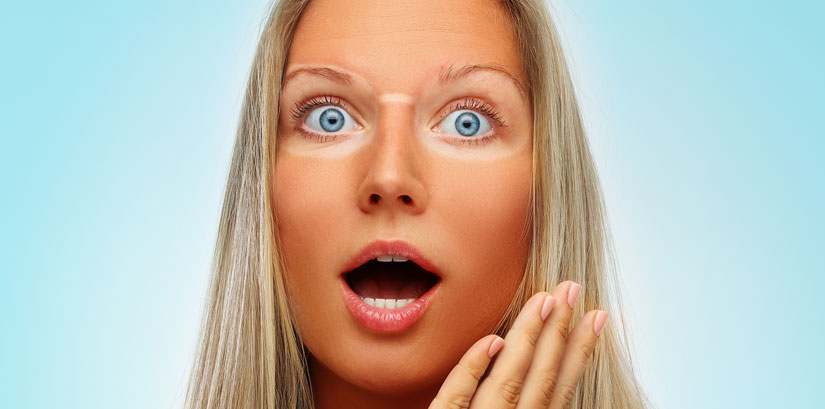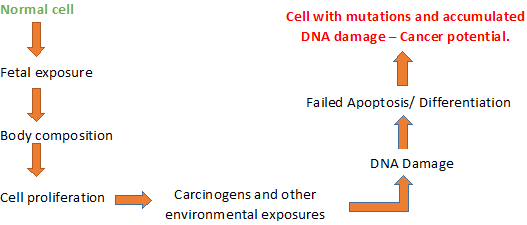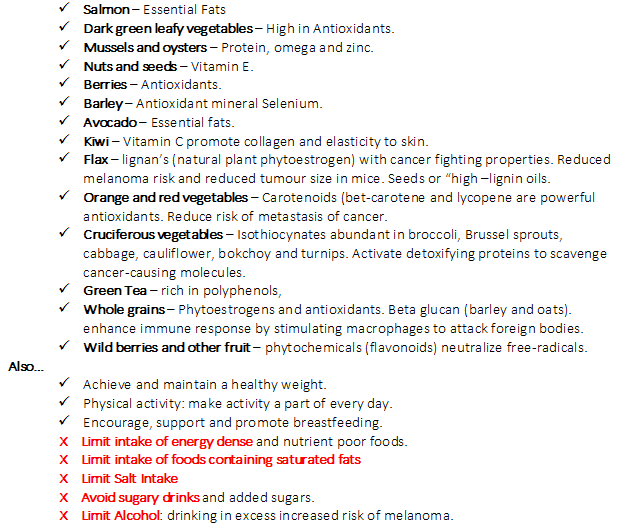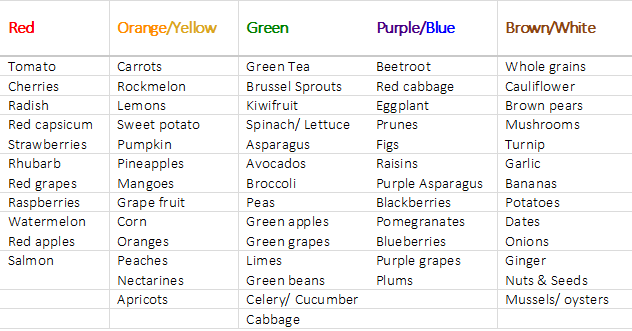Nourishing Your Skin Against Skin Cancer
- December 2, 2015
- Posted by: Spotscreen
- Category: Articles

After Cardiovascular disease, cancer is the second leading cause of death in most developed countries. About 1 in 3 people will be diagnosed with cancer during their lifetime, 60% of those diagnosed will die of cancer.
This week marks National Skin Cancer Action Week 2015. With 2 in 3 Australians diagnosed with skin cancer by the age of 70, this week is a time when we remind Australians of the importance of sun protection and early skin cancer detection.
Skin Cancer: More Than Genetics.
Do you hold the belief that whatever negative family history you have will inevitably repeat itself with you?
For many this common belief of disease state is still present, however it is safe to say that it is not warranted and you do not have to perpetuate your inherited history. New research in the cancer field indicates that genetics may not play as large a role in cancer risk as once thought and that environmental factors are of most importance.
Nutritional status plays an important role in the maintenance of healthy skin. Macro-nutrients (carbohydrates, proteins and lipids) and micro-nutrients (vitamins and essential minerals) work together to maintain the function of the skin as a protective barrier. A highly nutritious diet can complement traditional sun safety measures (sunscreen, protective clothing, hats and eye wear), leading to a stronger, healthier protective barrier for the body.
Challenges faced by healthy skin.
Skin provides a physical and chemical barrier between the outside environment and the inside tissues of the body. This barrier function is critical to protect underlying tissues from pathogens, chemicals, and environmental exposures. Balanced nutrition complements the preservation of skin health. Furthermore, skin that functions properly has aesthetically pleasing properties, giving it a healthy appearance and feel.
Skin integrity and ageing.
Changes in nutritional status that alter skin structure and function can also directly affect skin appearance. Collagen and elastin give skin its firmness and elasticity. With age there is a gradual decline resulting in looser, weaker and drier skin. As a compounding effect the fat pads under the skin also begin to diminish, wrinkles appear and skin sags. All these skin changes can make elderly skin more prone to sun damage, skin lesions and cancer.
Loss of integrity is due to:
- Genetics
- Cumulative sun damage (photo ageing)
- Direct chemical effects from abrasive chemicals and cigarette smoking
- Diet
Nutrients assist to improve skin texture and reduce the risk of sunburn by strengthening elastin and collagen. Numerous studies have linked high intake of mono-unsaturated fats, olive oil, olives, vegetables (leafy greens, spinach, eggplant, asparagus, onion and garlic), legumes, fruit (particularly prunes and apples), eggs, and reduced fat dairy, tea and water, with less wrinkling. In contrast; high intakes of saturated fats, processed meats, full fat dairy, refined sugary sweets (cakes and ice-cream), potatoes, butter and margarine were associated with more wrinkling.
Carcinogens and nutrition’s influence.
Carcinogenesis is a process by which cancer can develop and what we eat can play a role in each stage. What we eat can encourage progression or slow down the growth or spread of tumours by the lymphatic system.
Skin Cancer mechanisms. The progression of a normal cell into one with cancer potential involves numerous stages, each of which we can influence. We have the power to intervene with the right dietary habits, healthy weight maintenance and sun safety measures from pregnancy right through to adulthood.

Nourishing your skin.
Changes in the appearance of skin were associated with poor nutrition long before any biochemical relationships were discovered. Bleeding gums, skin discoloration, abnormal hair growth, and poor wound healing associated with the vitamin C deficiency disease known as scurvy was the first nutrient association made, followed by the skin abnormality pellagra (Vitamin B3 deficiency).
Since Ultraviolet light exposure depletes antioxidant levels in the skin, including ascorbic acid (vitamin C) and α-tocopherol (vitamin E), increasing antioxidant defences in skin cells and/or nutritional support of cellular repair enzymes are also important routes to limit sun damage.
The Fat Soluble Vitamins: A, D, E and K.
Vitamin A – Participates in cell differentiation, maintaining the health of epithelial tissues and skin. The epithelial tissue o the outside of the body is of course the skin – and vitamin A helps to protect against skin damage from the sunlight. With inadequate Vitamin A the epithelial cells change shape and begin to secrete the protein keratin (hard inflexible protein of the hair and nails). Overtime skin becomes dry, rough and scaly as lumps of keratin accumulate.
Rich Food Sources:
Yellow/ orange – pumpkin, carrots, capsicum and sweet potato.
Greens – Dark leafy vegetables such as spinach, broccoli and kale.
Other – Fortified milks and Liver.
Vitamin D – Different from all other nutrients in that the body can synthesize it with the help of the sunlight. Ultra- violet radiation from the sun converts the Vitamin D precursor in the skin converting it to pre-vitamin D3 and eventually the active form calcitriol. Numerous functions, in particular targeting tissues including cells of the skin and bone health.
Rich Food Sources:
Although sun exposure is the major source of Vitamin D in our bodies. Vitamin D is also found in a limited range of foods such as oily fish (salmon, herring and mackerel), egg yolk, fortified skim milks, powdered milk, cheese and yoghurt.
As stated in ‘The Number 1 Guide To Preventing Skin Cancer: Proven Advice From An Expert.’
Ingesting the equivalent of three button mushrooms four times a week will maintain your serum D3 levels. To increase the Vitamin D levels of the mushrooms, they need to be prepared by keeping the skin ON them. Chop the cap into smaller pieces then expose it to direct sunlight for six hours day over two days. It is able to fully absorb and store Vitamin D for twelve months. Alternatively, you may purchase organic mushrooms which have had short burst UVR treatment.
Vitamin E: The Antioxidant. One of the bodies’ primary defenders against the adverse effects of free radicals. Protects lipids, vulnerable cell components and their membranes from destruction.
Rich Food Sources: Plant Oils (olive, sunflower, safflower, wheat germ and cottonseed), nuts and seeds.
Other: wholegrain (wheat, barley and oats) cereals and legumes, fruit and vegetables.
Vitamin E, other fatlike -soluble vitamins, is susceptible to destruction during food preparation, processing, and storage. Due to its sensitivity to heat processing (such as deep frying) and oxidation, fresh and lightly processed foods are the preferable source. Therefore most processed convenience foods do not contribute enough Vitamin E to ensure adequate intake.
Vitamin K – Wound healing (Synthesis of blood clotting proteins). Nutritional support of the regenerating dermis layers during the final stages of wound healing is not only important in long-term wound resolution but is thought to promote the restoration of strong, healthy skin.
Dry skin is an effect of changes to the epidermal barrier (water loss to the environment) often due to atmospheric conditions and exposures.
If left untreated dry skin has increased sensitivity to the elements; particular UV radiation from the sun leading to cycles of cell damage and inflammation. This is all the result of the bodies’ inability to repair and regenerate damage to cells.
Your Nutrient Shield.
Fruit and vegetables among other foods fall into five different colour categories: red, orange, green, purple/blue, and white/brown. It is the phytochemicals within each colour that give fruits and vegetables their vibrant colour but also act as disease fighting chemical and our bodies personal health shield.
Plant foods: eat mostly foods of plant origin.
Animal foods: limit intake of red meat and avoid processed/cured meats.


Nurture the skin you’re in, it is the only one you have!
Spotscreen offers a range of tailored nutrition-based seminars designed to support healthy skin, nutritious diets and improved overall health and well being at your workplace. If you would like to enquire, please get in contact with us.
Leave a Reply
You must be logged in to post a comment.
